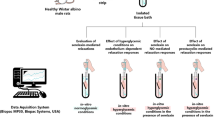Abstract
In extracavernosal vascular tissue, smooth muscle tone is modulated by a balance between angiotensin II (Ang II) and nitric oxide (NO). We hypothesized that these substances also play an important role in regulating cavernosal smooth muscle contractility. We therefore studied the in vitro effects of an Ang II receptor antagonist and a nitric oxide synthase (NOS) inhibitor on the contractile effects of Ang II, phenylephrine, and electrical field stimulation in canine corpus cavernosum. Ang II caused a dose-dependent contraction of cavernosal smooth muscle which was inhibited by the Ang II receptor antagonist and augmented by NOS inhibition. Contractions induced by phenylephrine or electrical stimulation were diminished by the Ang II receptor antagonist, and augmented by NOS inhibition. We conclude that Ang II plays an important role in modulating cavernosal smooth muscle tone, and that the contractile effect of Ang II on cavernosal tissue is modulated by the local NO environment.
Similar content being viewed by others
Author information
Authors and Affiliations
Rights and permissions
About this article
Cite this article
Comiter, C., Sullivan, M., Yalla, S. et al. Effect of angiotensin II on corpus cavernosum smooth muscle in relation to nitric oxide environment: in vitro studies in canines. Int J Impot Res 9, 135–140 (1997). https://doi.org/10.1038/sj.ijir.3900261
Received:
Accepted:
Issue Date:
DOI: https://doi.org/10.1038/sj.ijir.3900261
- Springer Nature Limited
Keywords
This article is cited by
-
Hypertension and urologic chronic pelvic pain syndrome: An analysis of MAPP-I data
BMC Urology (2024)
-
Local renin–angiotensin systems in the genitourinary tract
Naunyn-Schmiedeberg's Archives of Pharmacology (2012)
-
Physiological regulation of penile arteries and veins
International Journal of Impotence Research (2008)
-
Association between the insertion/deletion polymorphism of the angiotensin-converting enzyme gene and erectile dysfunction in patients with metabolic syndrome
International Journal of Impotence Research (2008)
-
Cardiovascular drug use and the incidence of erectile dysfunction
International Journal of Impotence Research (2007)




